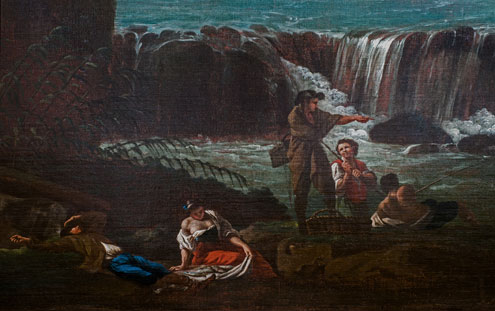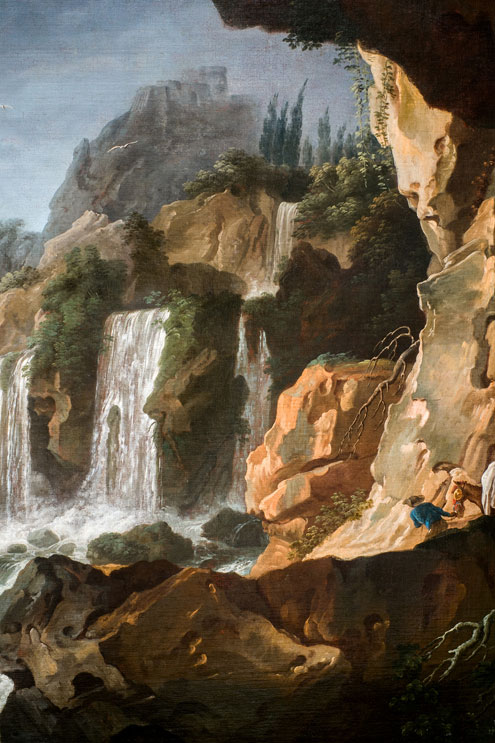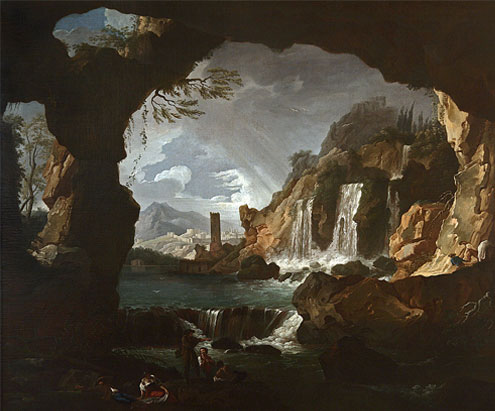Claude-Joseph VERNET
Claude-Joseph VERNET
(1714 Avignon – 1789 Paris)
"Vue des Cascatelles de Tivoli"
c. 1737 - 1740
119 x 141 cm - 47 x 55½ in.
Preliminary version to the picture in the collection Musée du Louvre, Paris
Preis auf Anfrage
Diese E-Mail-Adresse ist vor Spambots geschützt! Zur Anzeige muss JavaScript eingeschaltet sein!
Provenance: 1740 Henri Joseph Eugène de Villardi, Comte de Quinson, Marquis de Montlaur 1864 collection Eugène de Montlaur, Chateau de Lyonne / Vichy 1931 Joseph de Boutray, Paris 1966 with Galerie Heim-Gairac, Paris by 1989 George Encil collection, Bahamas 1990 Sotheby’s London where acquired by Prof. Dr. Friedhelm Beuker, Düsseldorf Meerbusch 1995 Lempertz Cologne Private collection, Germany JOSEPH VERNET painted several views of the Roman Campagna, in particular the locations around Tivoli. Eighteenth-century critics admired in his landscapes the "truth" they were looking for, as stated with enthusiasm by La Font de Saint-Yenne in his commentary on the Salon of 1746, where Vernet was exhibiting for the first time. Diderot praised the picturesque effects, the play of light and water, that „science of effect“ in the artist’s work, commenting 1767 that one could "visit" a painting by Vernet just as one may visit a natural site. Vernet painted three variants of “Vue des Cascatelles de Tivoli”, one of them today in the Louvre. Not an accurate depiction of the actual site, the subject is an imaginary composition based on a view of the famous Neptune’s Grotto at Tivoli. Philip Conisbee, the late Vernet specialist who prepared a critical catalogue raisonné, dated the composition as early in Vernet’s roman career. The 20 year old artist arrived 1734 in Rome, first trips to Tivoli and Naples are reported 1737. His early works in the style of Salvator Rosa with a restricted palette of warm and subtle browns, ochres and olive greens were most sought after by eighteenth-century collectors. Conisbee compared the „broad and brushy facture“ of the Louvre version with the 1737 “Tivoli Waterfalls” in the Cleveland Museum of Art (121 x 170 cm, Ingersoll-Smouse n°554) or „even closer“, with the 1738 “Rocky Landscape in Italy“, in the Dulwich Picture Gallery (119 x 170 cm, Ingersoll-Smouse n°466), which are the earliest known dated works from the Italian period.1 The present work, a slightly smaller variant of the Louvre painting (canvas 124 x 160 cm, Inv. 8332), reappeared in the mid-1960s and was purchased by the Canadian George Encil, who had his important art collection published in 1989. The painting shows compared to the Louvre version a less detailed execution in the rocks which appear broader in touch - according to Conisbee characteristic for early works like the dated Dulwich landscape. Other details as the treatment of the sky, the town in the background, the figures and technical aspects like the opaque green touches to structure the dark parts of the grotto and the red preparation of the canvas are virtually identical to the Louvre version. The same composition on a narrower format is achieved by slight variations, visible for instance by the changed position of the person leading a donkey in relation to the cracks in the rock behind. Vernet reused the Neptune’s Grotto as a setting for his famous work “Les Baigneuses” 1759, 66.5 x 82.5 cm (Lempertz Cologne, 17 november 2006, lot 1332 – provenance: Sotheby’s London, 5 july 1995, lot 83 - British Rail Pension Fund collection), where the background is changed to a marine with a romantic sunset in a palette typical for his mature style. The illustrious provenance of the present work has only recently been entirely traced: 1740 Vernet traveled with the Comte de Quinson, one of his first patrons who became a close friend and acquired two important landscapes, leading the artist’s “Livre de Raison – Reçus” as entry n°1.2 These two pictures, one of them described as “Cascatelles de Tivoli”, remained in the collection of his heir Eugène de Montlaur (1815-1895)3. His son, the 7th Vicomte de Montlaur, Humbert-Eugène (1850-1931) died without direct descendants. The estate went in the 1960s to his nephew Joseph de Boutray (1895-1977) who dispersed the art collection and finally sold Chateau de Lyonne in 1976.4 1 Letter to Guillaume Faroult, Curator of paintings, Musée du Louvre, 02 november 2003 2 Livre de Reçus, published by Lagrange 1864, p.359 : “1. Pour M. le comte de Quinson deux tableaux en toile d’empereur un une cascade et l’autre une Marine…120 Ecus romains” According to Lagrange both men had a close relationship, proven by the correspondence in possession of the Montlaur family by 1864. 3 Lagrange 1864, p.483 : “Chez le marquis Eug.de Montlaur [Humbert-Eugène-Léopold de VILLARDI QUINSON de MONTLAUR,1850 -1931] Naufrage – Pêche du thon – Les Blanchisseuses. Chez le même, au château de Lyonne, près Vichy : Cascatelles de Tivoli – Côtes de la Méditerranée, route de la corniche. – voir page 26” 4 Hervé de Montlaur (e-mail communication, 15 oct. 2010) Bibliography : L.Lagrange, Joseph Vernet, sa vie et son oeuvre, Paris 1858 L.Lagrange, Joseph Vernet et la peinture du XVIIIème siècle, Paris 1864, p.26-27, 359, 483 F.Ingersoll-Smouse, Joseph Vernet peintre de marine 1714-89, vol.1, Paris 1926, p.18 + 111, no 467; n°41 Ph.Conisbee, Salvator Rosa and Claude-Joseph Vernet, Burlington Magazine, n.849, december 1973, pp.789 Ph.Conisbee, Joseph Vernet 1714–1789, exhibition catalogue Kenwood 1976 and Musée de la Marine, Paris 1977 V.Prat, Experience and Adventures of a Collector, The George Encil Collection, Paris 1989, pp.182 + 428 ; V.Prat, La fascinante collection de l’inventeur des téléskis, Supplément Arts Figaro-Magazine, nouvelle série n°31, Paris, 25 june 1988; G.Faroult, Le tableau du mois no.107: vue d’une cascade à traverse des rochers, dite „Vue des cascatelles de Tivoli“ de Joseph Vernet, Musée du Louvre, Paris 2004




